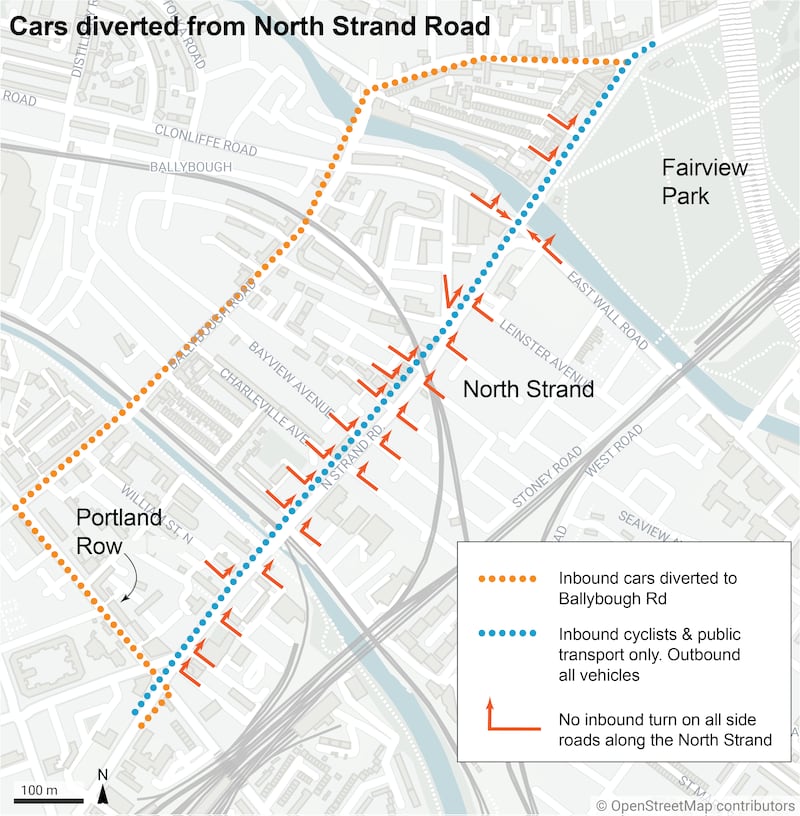Light traffic on the first day of the new one-way system on North Strand did not deter a significant number of motorists from illegally using the bus lane to access Dublin city on Monday morning.
The ban on cars travelling inbound to the city on North Strand, one of the busiest roads on Dublin’s northside, has been introduced by Dublin City Council to facilitate the construction of the Clontarf-to-city-centre cycle route.
Restrictions, planned to last until 2024, require private cars, vans and lorries coming into the city at Fairview to divert at Edge’s Corner on to Fairview Strand and Ballybough Road. Motorists can either continue on Summerhill to reach the city centre, or can use Portland Row to access the Five Lamps and Connolly Station on Amiens Street.
Residents on dozens of small roads that feed on to North Strand who want to drive into the city will also be blocked from using the road inbound and will have to first drive north out of town to head back south on the diversion route.
READ MORE

Most motorists on Monday morning obeyed the diversion signage, which was in place not only in Fairview but on roads north of the area to allow people to chose alternative routes at an earlier stage.
However, significant numbers of car and commercial vehicle drivers illegally used the bus lane and did not stop for construction workers who asked them to divert.
Victor Coe, senior executive engineer with Dublin City Council, said Garda enforcement would be implemented if motorists did not obey the diversions.
“We have three phases on that front. One is to initiate the diversion first to see how the public comply. We have ongoing consultation with the gardaí and if people aren’t going to heed the diversion we will take it to the next step, which is getting gardaí involved, with policing first, and then long term with enforcement.”
Traffic was light during Monday morning’s peak period, with some congestion on Fairview Strand but few tailbacks on Ballybough Road and Summerhill. However, Mr Coe conceded it was likely congestion would become an issue from September.
“It is going to be a transformative project for the city and it will be great when it’s finished. We hope that the public will bear with us during the construction of this project because there will be inevitable delay and disruption in a project of this scale,” he said.
“If you’re coming into Dublin you will be delayed and disrupted by having to take the diversion but if you’re coming out of Dublin there should be little or no disruption or delay to you.”
Leaflets advertising the restrictions had been distributed to 60,000 homes, he said – which appeared to have resulted in fewer people attempting to drive into the city from the northeast.
“We would like to thank the people who have listened to the message that we have put out over the past couple of weeks to discourage people from travelling on this particular route and take other routes into town, or to use different modes of transport or to start cycling or walking into town. We’d like to thank the people of Dublin for doing that.”
The use of buses would become particularly important as traffic returned to normal levels next month, he said.
“In a normal rush hour there are about 600 cars that head down Annesley Bridge Road [from Fairview to North Strand]. If people in those 600 cars got into buses that would be 7½ buses. That’s what we want, to encourage more people to get into buses.”
The cycle route, first proposed a decade ago, is part of a €62 million project that also involves watermains works and new bus lanes. The route will provide safe access from the city to the off-road Dublin Bay cycle path, which runs from Sutton to Clontarf. The project is scheduled for completion in 2024, but Mr Coe said he hoped the traffic restrictions will be finished earlier.
“We have advertised that it will be until early 2024, but we don’t anticipate that that will be the case. We are confident that the contractor will finish that work sooner than that.”












